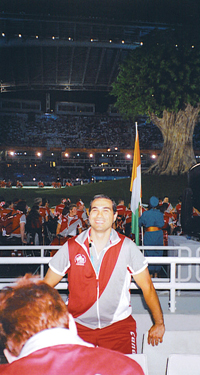
Features
Practice
Technique
Opa! From Greece
Treating at the 2004 Summer Paralympic Games in Greece was nothing short of amazing. I spent 21 days in a country that gave birth to the modern Olympics where countries set aside differences and watch their athletes compete for gold. And, compete they did.
September 28, 2009 By Remo Bucci MT SMT
Treating at the 2004 Summer Paralympic Games in Greece was nothing short of amazing.
I spent 21 days in a country that gave birth to the modern Olympics where countries set aside differences and watch their athletes compete for gold. And, compete they did.

|
|
|
The Paralympics takes place two to three weeks after the able-body Olympics using the same venues. Paralympics involve athletes that have a physical disability verses Special Olympics where athletes have a mental disability. The athletes I treated had spinal cord injuries (paraplegic and quadriplegic), cerebral palsy, congenital deformities, visual impairments, and amputations.
Most of these athletes have persevered through rehabilitation, stigma, ridicule, and depression to achieve the ultimate goal of having a gold medal around their neck, or to compete with the best in the world.
All of these athletes have stories that will make you want to cry, but don’t you dare have pity on them or you will get your toes crushed by a wheelchair. They consider themselves athletes, period, and when you watch them in action you will forget that they have a disability.
Wheelchair athletes taught me the wheelchair is a piece of sports equipment, as much as a football player has a helmet and shoulder pads. The Paralympians are as focused, determined, and driven as their Olympic counterparts. Even the wheelchair rugby players are as crazy as their able-bodied counterparts.
 Paralympians are humble and grateful for being at the games. The shooter team gave the therapists gifts to show their gratitude. They felt the quality of treatment available at the Paralympics was better than what they receive at home.
Paralympians are humble and grateful for being at the games. The shooter team gave the therapists gifts to show their gratitude. They felt the quality of treatment available at the Paralympics was better than what they receive at home.
My clinic time was divided between the Paralympic village for the first eight to nine days and the athletics warm-up track for the rest of the time. During the first two days in clinic I learned to modify my techniques, especially with spinal cord injures. Lighter pressure and slower speed for non-innervated tissue prevented spastic reflexes. Wheelchair athletes were able to transfer without help but some needed assistance with turning their legs.
In the clinic setting, my hours where from 9 a.m. to 9 p.m. and, on the warm-up track, 7 a.m. to 10-11 p.m. They were long hours but it was worth it. Two other therapists and I stayed until about 11 p.m. because Canadian athletes were in the finals and winning medals.
The finals, medal ceremony and media coverage all took place before they could come to get treatment.
The medical team consisted of three doctors and 14 therapists, including three massage therapists. The medical team complimented each other, and egos were checked at the door. It was a true multi-disciplinary approach for the common goal of having the athletes compete as injury free as possible.
This was my first time treating Paralympians and I am very grateful for the opportunity that the Canadian Sport Massage Therapists Association (CSMTA), the Canadian Paralympic Committee (CPC) and especially the athletes gave me.
This experience has taught me a new approach with clients who are injured and has enhanced my ability to teach massage therapy students about disability injuries.
Remo Bucci practices in Mississauga, Ontario at Club Physio Plus, inside Ontario Racquet Club and in Toronto at West Park ProActive Healthcare. He teaches second-year Treatments and supervises clinics at Elmcrest College in Toronto.
Print this page